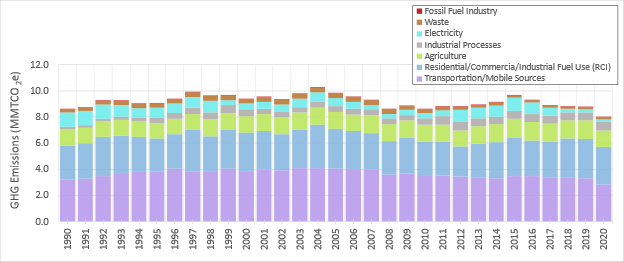PRESS RELEASE
For Immediate Release – May 1, 2023
Contact:
Stephanie Brackin, Communications Coordinator
stephanie.brackin@vermont.gov, 802-261-0606
Jane Lazorchak, Climate Action Office Director
jane.lazorchak@vermont.gov, 802-505-0561
Collin Smythe, Climate Change Data and Progress Analyst
collin.smythe@vermont.gov, 802-689-0003
ANR Climate Action Office Releases Annual Greenhouse Gas Emissions Inventory for Vermont
Montpelier, VT – The latest Greenhouse Gas Emissions Inventory and Forecast Report (1990-2020) has been released today by the Agency of Natural Resources (ANR) Climate Action Office (CAO). The report provides estimates of greenhouse gas emissions in various sectors of the Vermont economy.
As in prior years, the largest emitting sectors of GHG emissions in 2020 were transportation, building energy use, and agriculture. Vermont’s GHG emissions declined 10% percent from 2017 to 2020, as shown in Figure 1. The decrease in transportation emissions was responsible for most of this decline and was largely due to the global pandemic and Vermonters staying home. However, it remains to be seen how much of those emission reductions will remain long-term due to policies like telework being more prevalent since the pandemic.
Figure 1: Total and Sector-Based Vermont Greenhouse Gas Emissions (1990 – 2020)

In addition to providing sector-based estimates of greenhouse gas emissions, the GHG inventory is integral to assessing Vermont’s progress toward meeting the emission reduction requirements established in the 2020 Global Warming Solutions Act (GWSA): 26% below 2005 levels by 2025, 40% below 1990 levels by 2030, and 80% below 1990 levels by 2050.
Going forward, ANR will establish a specific date to release the GHG inventory each year.
“Releasing the inventory on the same date annually will help build trust with Vermonters," said Jane Lazorchak, the Director of the CAO. "Establishing clear expectations for when the updated inventory will be available is important since time is needed for the Agency to compile datasets and complete supplemental analyses in order to produce a consistent, high quality data product.”
The CAO will also be creating a public process to review any major changes made to the methodology used to calculate emissions. This is important because changes to how we estimate pollution can affect the level of emissions being reported in different sectors.
Learn more about Climate Action in Vermont.
###
